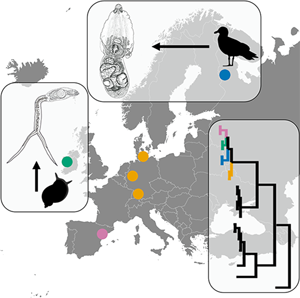Crossref Citations
This article has been cited by the following publications. This list is generated based on data provided by
Crossref.
Lebedeva, D.I.
Popov, I.Y.
Yakovleva, G.A.
Zaicev, D.O.
Bugmyrin, S.V.
and
Makhrov, A.A.
2022.
No strict host specificity: Brain metacercariae Diplostomum petromyzifluviatilis Müller (Diesing, 1850) are conspecific with Diplostomum sp. Lineage 4 of Blasco-Costa et al. (2014).
Parasitology International,
Vol. 91,
Issue. ,
p.
102654.
Krupenko, Darya
Kremnev, Georgii
Gonchar, Anna
Uryadova, Alexandra
Miroliubov, Aleksei
Krapivin, Vladimir
Skobkina, Olga
Gubler, Arseniy
and
Knyazeva, Olga
2022.
Species complexes and life cycles of digenetic trematodes from the family Derogenidae.
Parasitology,
Vol. 149,
Issue. 12,
p.
1590.
Faltýnková, Anna
Kudlai, Olena
Salganskiy, Oleksander O.
Korol, Eleonora M.
and
Kuzmina, Tetiana A.
2022.
Trematodes from Antarctic teleost fishes off Argentine Islands, West Antarctica: molecular and morphological data.
Systematic Parasitology,
Vol. 99,
Issue. 4,
p.
491.
Sokolov, Sergey G.
Yang, Peimin
and
Lebedeva, Daria I.
2022.
New record of Tylodelphys metacercariae (Diplostomidae) from Perccottus glenii (Odontobutidae) and their phylogenetic assessment.
Acta Veterinaria Hungarica,
Vol. 70,
Issue. 4,
p.
274.
Sokolov, Sergey G.
Ieshko, Evgeny P.
and
Lebedeva, Daria I.
2023.
Resurrection of Diplostomum numericum Niewiadomska, 1988 (Digenea, Diplostomatoidea: Diplostomidae) Based on Novel Molecular Data from the Type-Host.
Diversity,
Vol. 15,
Issue. 7,
p.
840.
Martinek, Inga
and
Hernández-Orts, Jesús S.
2023.
WITHDRAWN: Molecular identification of myxozoans and helminths in the black goby Gobius niger L. (Gobiiformes: Gobiidae) from the Finnish Archipelago, Baltic sea.
Current Research in Parasitology & Vector-Borne Diseases,
p.
100161.
Faltýnková, Anna
Kudlai, Olena
Pantoja, Camila
Jouet, Damien
and
Skírnisson, Karl
2023.
Prey-mimetism in cercariae of Apatemon (Digenea, Strigeidae) in freshwater in northern latitudes.
Parasitology Research,
Vol. 122,
Issue. 3,
p.
815.
Chaudhary, Anshu
Singh, Komal
Baliyan, Rakhi
Sharma, Bindu
and
Singh, Hridaya Shanker
2024.
Molecular phylogeny and morphological identification of two species of Diplostomum (Digenea: Diplostomidae) in fishes from the Ganga River, India: an integrative taxonomic approach.
Biologia,
Vol. 79,
Issue. 12,
p.
3589.
Martinek, Inga
and
Hernández-Orts, Jesús S.
2024.
Helminth fauna of the black goby Gobius niger L. (Gobiiformes: Gobiidae) from the Finnish Archipelago, Baltic Sea: Molecular and morphological data.
Current Research in Parasitology & Vector-Borne Diseases,
Vol. 5,
Issue. ,
p.
100169.
Izrailskaia, Anna V.
Besprozvannykh, Vladimir V.
and
Shchelkanov, Michael Yu.
2024.
Diplostomum cf. vanelli Yamaguti, 1935 (Trematoda: Diplostomidae Poirier, 1886): Morpho-Molecular Data and Life Cycle.
Diversity,
Vol. 16,
Issue. 5,
p.
286.
Alshehri, E.
Abdel-Gaber, R.
and
Al-Quraishy, S.
2024.
Identification tools of Diplostomum spathaceum Rudolphi, 1819 (Diplostomida: Diplostomidae), a trematode parasite of herring gull (Larus argentatus).
Arquivo Brasileiro de Medicina Veterinária e Zootecnia,
Vol. 76,
Issue. 4,
Lebedeva, D. I.
Sukhovskaya, I. V.
Kochneva, A. A.
Lysenko, L. A.
Kantserova, N. P.
Zaitsev, D. O.
Milyanchuk, N. P.
and
Ieshko, E. P.
2024.
Molecular and morphological description of <i>Diplostomum spathaceum</i> metacercariae from <i>Abramis brama</i> l. Of Lake Syamozero (North-West Russia).
Parazitologiâ,
Vol. 58,
Issue. 6,
p.
457.
